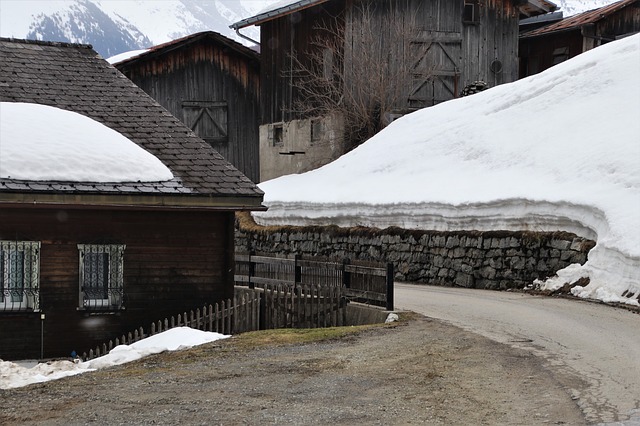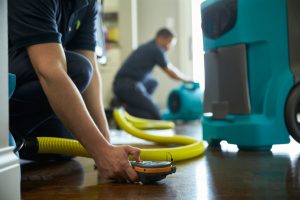The state of Illinois has seen some drastically low temperatures and fierce snowstorms, so much that the city of Chicago has had a hard time plowing simply because there isn’t enough space to put it all. Blizzards and flurries can look elegant when watching from inside your warm home, but what most don’t realize is that a lot of snow can be incredibly dangerous, both when frozen and melting.
Most homeowners are aware of winterizing their home, such as turning off the water to their hoses and sprinkler heads and caulking the windows. But one must be equally careful once springtime comes in. It’ll be nice to have temperatures above freezing, but when the snow melts, there is always the risk of water damage.
Everything from slush, mud, and water to heavy rain is all part of spring, so Illinois residents are always in for a wet season. But in addition to dirtying everything, melting snow can be disastrous to your home, specifically foundations and personal items both inside and out. Especially if there are large amounts of snow melting, it’s time to get started in protecting your property.
How to Protect Your Home from Melting Snow
The following steps won’t fully ensure your home will be protected from melting snow, but they can drastically decrease your chances of dealing with water damage, especially in regard to flooded basements. Be sure to check off all the following from this list.
- Check all pipes for leaks and damage. This goes for pipes both inside and out of the home. Frozen pipes can always be found just before spring hits, and they must be thawed out right away to prevent them from bursting. Outdoor pipes should also be inspected as the ice can cause critical damage throughout the winter.
- Clear the snow from the storm drain. Most home foundations sit on a slight hill to allow water to flow away from the home and into the street. But if the storm drain is clogged with slush and mud, it will build up and create a backflow toward the home and the street.
- Check your roof. Just as the weight of snow can cause a roof to cave in, that much melting snow can also cause a leak in your roof. Especially if they haven’t been replaced in a while, old and damaged shingles won’t be enough to keep the water from flowing into your attic. If this is not checked, you may even experience mold growth as a result of excess moisture.
- Shovel the snow. Be cautious as the snow will feel heavier once it melts, but it’s still important to get it away from downspouts, basement windows and stairwells to prevent it from flowing into your foundation and basement.
- Clear snow from the roof gutters. As the snow melts from the roof, it will travel downwards to the gutter and to the downspout. But if the gutters are blocked, it will pool over the side and sink into your foundation, rendering the gutter and downspout useless. Just be careful when climbing up the ladder. If you’re afraid of heights or are unsure of what you’re doing, don’t hesitate to contact a contractor as its simply not worth the risk of getting injured.
- Inspect the property for all other obstructions. In addition to the downspout, gutter, storm drain and other items that allow water to flow away from your foundation, be sure to check for any other obstructions that might lead to water damage. This can include pools, garden beds or dips in your foundation that might prevent water from flowing into the storm drain.
Damage from Melting Snow: What to Do
Again, there’s no way to ensure melting snow won’t damage your property as you can only reduce the risk. But when it does find a way in, it’s critical to react immediately as it will only become worse with time. Porous materials like carpeting, insulation, furniture, and drywall face the highest risk of damage to their ability to soak up large amounts of water.
Mold damage is another issue that can cause a whole new set of problems if the moisture is allowed to sit for any longer than 24 hours. Once it grows, it will eat away at the affected material as well as trigger a number of respiratory and allergy issues.
Water Damage Restoration Services
If the water damage is extensive beyond repair, it’s best to call a water damage restoration company right away, such as ServiceMaster S&R Systems for those living in the Aurora, IL area. Be sure to identify the source of the damage, such as where the melting snow is coming in as well as moving it away from the damaged area.
As soon as ServiceMaster S&R Systems arrives, we will address the most at-risk surfaces first, such as drying or replacing any wet drywall, carpeting and other floorings. After setting up powerful air movers and dehumidifiers, we will apply anti-microbials to prevent the risk of mold growth. But if it has already started growing, our mold removal services will be able to remove it at the source as well as eliminate the surrounding spores.
Once the materials are dried and mold spores are removed, any destroyed building materials will be disposed of and replacements will be installed. We will also work with your insurance company during the claims process to allow for additional peace of mind.
Available 24/7
Don’t hesitate to contact ServiceMaster S&R Systems at (630) 896-0030 for professional water damage restoration and mold removal services at any time your home in the Aurora, IL area has been damaged by melting snow.



